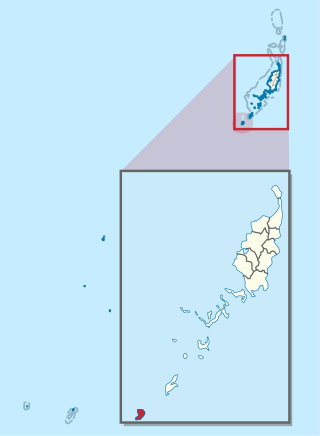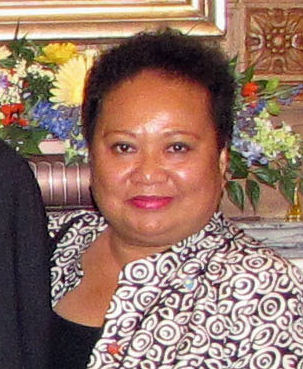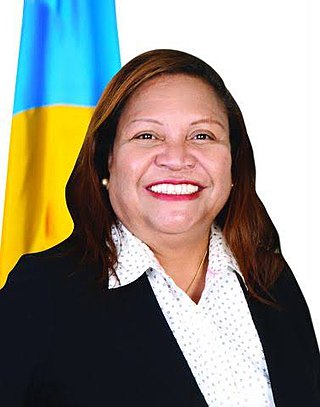
Palau, officially the Republic of Palau, is an island country in the Micronesia subregion of Oceania in the western Pacific. The republic consists of approximately 340 islands and connects the western chain of the Caroline Islands with parts of the Federated States of Micronesia. It has a total area of 466 square kilometers (180 sq mi), making it one of the smallest countries in the world. The most populous island is Koror, home to the country's most populous city of the same name. The capital Ngerulmud is located on the largest island of Babeldaob, in Melekeok State. Palau shares maritime boundaries with international waters to the north, the Federated States of Micronesia to the east, Indonesia to the south, and the Philippines to the northwest.

Palau was initially settled around 1000 BC.

Angaur, or Ngeaur in Palauan, is an island and state in the island nation of Palau.
The Micronesians or Micronesian peoples are various closely related ethnic groups native to Micronesia, a region of Oceania in the Pacific Ocean. They are a part of the Austronesian ethnolinguistic group, which has an Urheimat in Taiwan.

Ngaraard is the eighth state of the Republic of Palau, and was originally named Kerradel.
Modekngei, or Ngara Modekngei, is a monotheistic religious movement founded around 1915 by Tamadad, a native of the island of Babeldaob, that spread throughout Palau. It rose to political significance between the First and Second World Wars and is currently professed by 5.7% of Palau's population. Modekngei is a hybrid of ancient Palauan customs and Christianity. Followers of the religion believe in the Christian God, recognize Jesus Christ as the Messiah, and simultaneously make appeasements to the traditional Palauan deities.

Elias Camsek Chin is a Palauan politician. He served as the Vice President of Palau from 1 January 2005 to 15 January 2009. He was elected as the president of the Senate of Palau from 16 January 2013 to 19 January 2017.

Sandra Sumang Pierantozzi is a Palauan politician. She served as the country's Vice-President from 19 January 2001 to 1 January 2005. Pierantozzi was defeated by Camsek Chin in the 2 November 2004 vice-presidential election, winning only 28.9% of the vote.

Ngardmau is one of Palau's sixteen states and is located on the west side of Babeldaob between the states of Ngaraard and Ngeremlengui.
Elicita 'Cita' Morei is a Palauan women's liberation and anti-nuclear weapons activist and writer. She is a member of the Belauan women's organization, Otil a Beluad and author of Belau Be Brave and Planting the Mustard Seed of World Peace.

The Belau National Museum (BNM), previously Palau Museum, is a museum in Koror, Palau. It is the oldest continuously run museum in Micronesia.
There is a small Japanese community in the Pacific Island country of Palau, which mainly consists of Japanese expatriates residing in Palau over a long-term basis. A few Japanese expatriates started to reside in Palau after it gained independence in 1994, and established long-term businesses in the country. Japanese settlement in Palau dates back to the early 19th century, although large scale Japanese migration to Palau did not occur until the 1920s, when Palau came under Japanese rule and administered as part of the South Seas Mandate. Japanese settlers took on leading administrative roles in the Japanese colonial government, and developed Palau's economy. After the Japanese surrender in 1945, virtually all of the Japanese population was repatriated back to Japan, although people of mixed Japanese-Palauan descent were allowed to remain behind. People of Japanese-Palauan descent constitute a large minority of Palau's population as a result of substantial intermarriage between the Japanese settlers and Palauans. They generally identify with, conforming to cultural norms and daily lives with the Palauans.

Women in the Federated States of Micronesia are women who live in or are from the Federated States of Micronesia, an independent sovereign island nation composed of four states. Thus, FSM women includes women from the States of Yap, Chuuk, Pohnpei and Kosrae.

William Vincent "Vit" Vitarelli, also referred to as Rubak in Palau, was an American educator and architect. He worked for the Trust Territory of the Pacific Islands (TTPI) from 1948 to 1970. He was stationed in various islands in Micronesia, including Palau and Ebeye, and participated in various educational and community development projects.

J. Uduch Sengebau Senior is a Palauan lawyer, judge, and politician who has served as the Vice President of Palau since 2021. She was previously a member of the Senate of Palau from 2013 until she took office as Vice President.
Mirair Gabriela Ngirmang was a Palauan peace and anti-nuclear activist.

Yutaka Miller Gibbons was the Ibedul of Koror and the Chairman of the Council of Chiefs. He was also an anti–nuclear weapons activist and political candidate.
Olympia E. Morei-Remengesau is a curator from Palau, who was appointed Director of Belau National Museum in 2009. Born in Koror State, she began work at the museum as an administrator, before moving to the role of Assistant to the Director. She is co-vice chair of the Kraemer Ethnography Translation Project, which translated the works of Augustin Krämer from German to Palauan, and was funded by the German government. She is also the National Representative for the Federation of International Dance Festivals (FIDAF). In 2019 she secured a $10,000 donation from Taiwan to fund a new exhibition to celebrate the 25th anniversary of Palau's independence. During the COVID-19 pandemic, she led the museum, enabling it to continue its community work despite being forced to lay off several members of staff.















